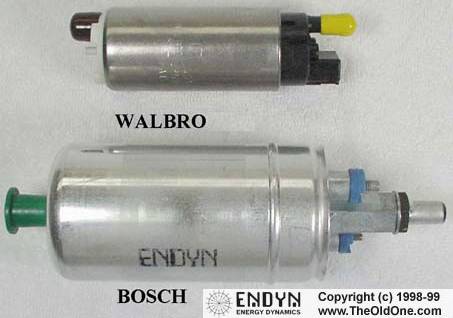
|
|
||||||||||||
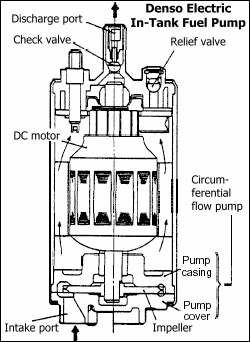 The solution for more power out of the 3000GT/Stealth (3S) turbo models, in its simplest form, is just to add more air (increase boost) and add more fuel. After a point, in order to add more fuel, a larger-capacity-than-stock fuel pump is required, along with larger injectors and a fuel-mixture controller. The fuel pump must be able to supply the amount of fuel required by all the injectors in wide open throttle (WOT) conditions at the maximum boost level anticipated. A 20% safety margin (that is, the pump can supply 20% more fuel than is actually required) is often cited to avoid overheating the pump or a momentary lean mixture (and possible damage to pistons, valves, or rings).
The solution for more power out of the 3000GT/Stealth (3S) turbo models, in its simplest form, is just to add more air (increase boost) and add more fuel. After a point, in order to add more fuel, a larger-capacity-than-stock fuel pump is required, along with larger injectors and a fuel-mixture controller. The fuel pump must be able to supply the amount of fuel required by all the injectors in wide open throttle (WOT) conditions at the maximum boost level anticipated. A 20% safety margin (that is, the pump can supply 20% more fuel than is actually required) is often cited to avoid overheating the pump or a momentary lean mixture (and possible damage to pistons, valves, or rings).
| Kenne Bell | Boost-a-PumpTM | |
| Jacob Electronics | Accuvolt FR-750 | |
| Aeromotive | Billet Fuel Pump Controller | |
| Ramchargers | Volt Blaster |

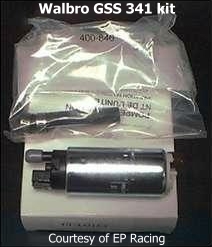
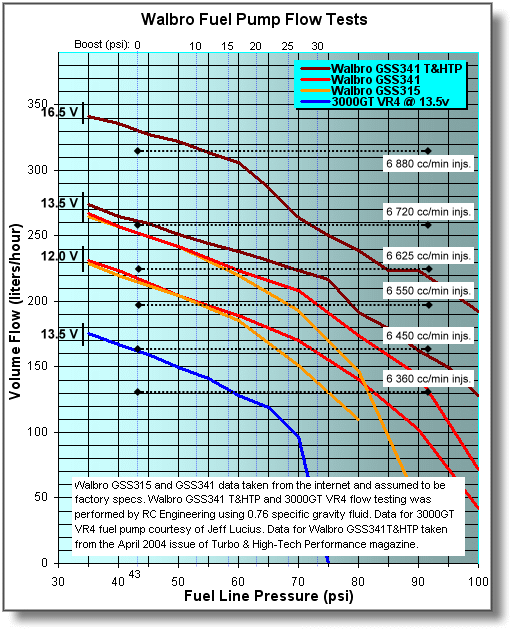
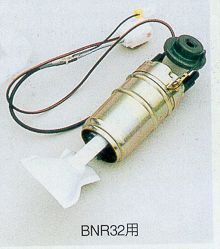
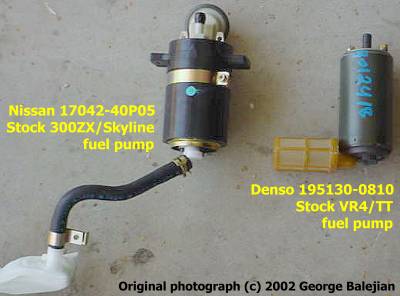
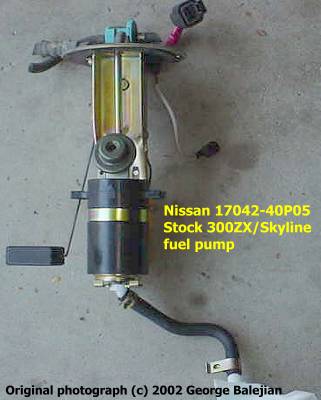
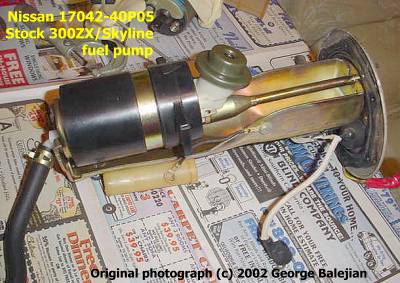
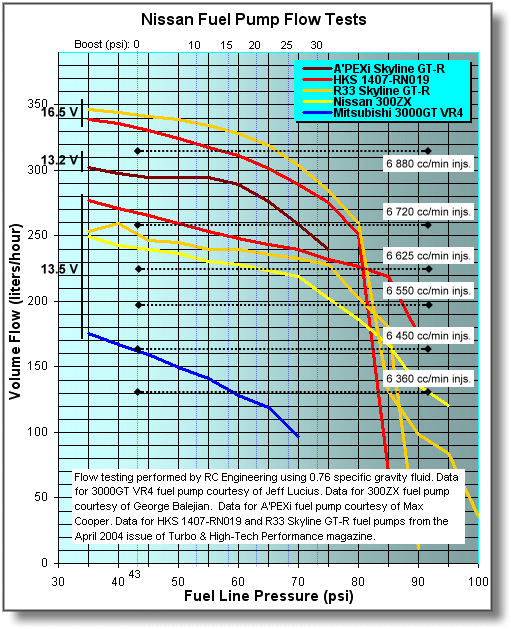
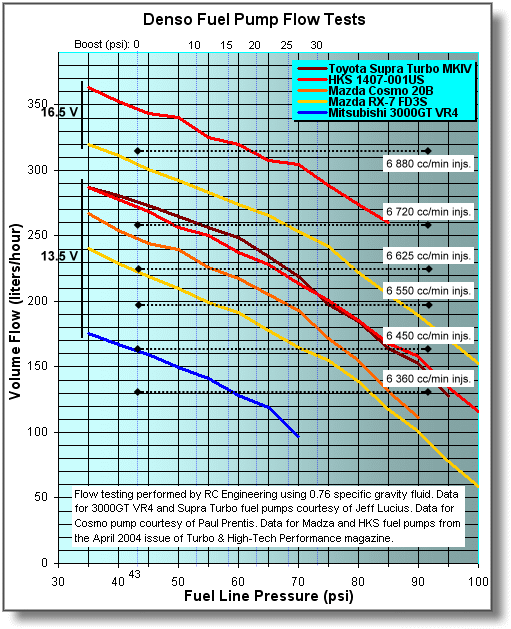
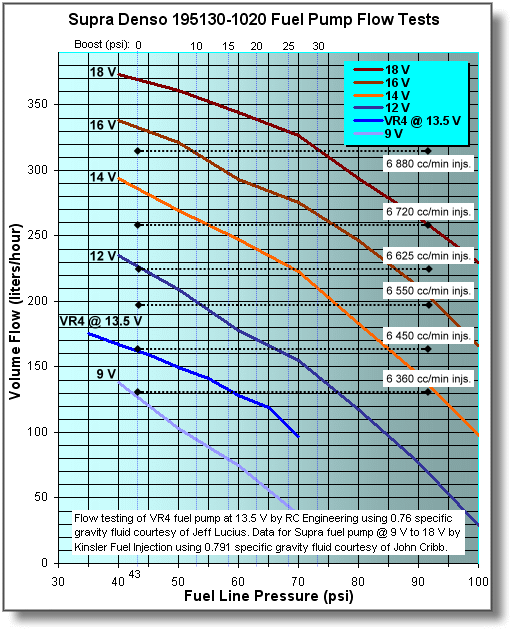
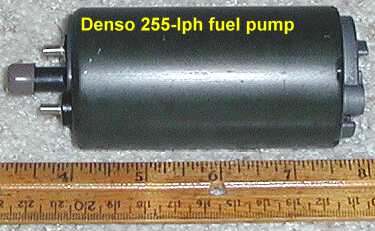
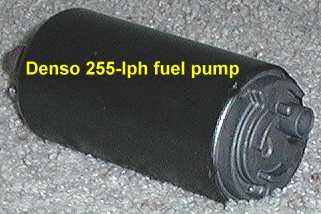
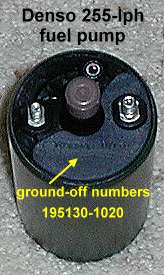
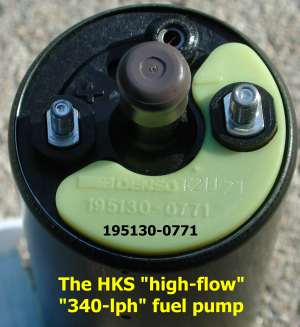
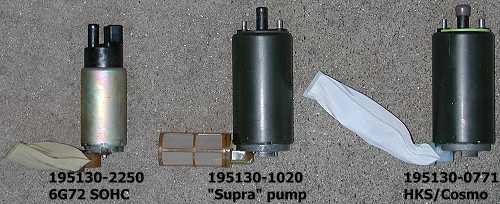
| Fuel Pumps for the 3000GT/Stealth | ||||
|---|---|---|---|---|
| Name | Part Number |
Rated flow lph @ 43psi @13.5V |
Rated flow gph @ 43psi @13.5V |
Comments |
| Mitsubishi VR4 | Denso 195130-0810 |
180 | 48 | This pump also may be used in the Celica GT-4.
Measured at 163 lph @ 43 psi @ 13.5 V for a used pump. Light blue or green tag on top. |
| Mitsubishi Evo8 | Denso 195130-3360 |
191 | 51 | Factory pump in the Lancer Evo8. Flow data from T&HTP.3 Design is like the 3000GT NA pump so an adapter would be needed for the pickup tube and electrical connection on TT models. An upgrade for NA cars. |
| Bosch | Bosch 10208 |
210 | 55 | Flow data is from The Old One
Requires modifications to the pump assembly. |
| Mazda RX-7 Turbo | Denso 195130-0782 |
223 | 59 |
Flow data from T&HTP.3 Road///Race Engineering says 210 lph @ 12 v. |
| Nissan 300ZX Turbo (Skyline the same?) |
Nissan 17042-40P05 |
241 | 64 | This flow data is from RC Engineering tests for George Balejian. Requires modification to pump assembly pickup tube. Dealer list price is ~$300. ABC Nissan (1-800-500-8722) may sell it at a 25% discount (~$227). |
| Mazda Cosmo 20B | Denso 195130-0771 |
248 | 66 | This flow data is from RC Engineering tests for Paul Prentis Jr. Road///Race Engineering reports 250 lph flow. Yellow tag on top. |
| Nissan Skyline R33 | Nissan ??? |
252 | 66 | Stock pump.3 Requires modification to pump assembly pickup tube. |
| Walbro | Walbro GSS 341 |
262 | 69 |
This flow data from T&HTP.3 Flow data from Auto Performance Engineering says only 255 lph. The Walbro 341 can be purchased from Extreme PSI for about $100. An adapter is required for the pickup tube and electrical connection. |
| HKS Skyline R33 | HKS 1407-RN019 |
268 | 71 | Relief valve opens near 90 psi.3 Requires modification to pump assembly pickup tube. |
| Mines Skyline | Mines ??? |
270 | 71 | Mines and their retailers do not mention voltage or pressure. |
| HKS In-Tank | HKS 1407-001US Denso 195130-0771 (modified) |
272 | 72 |
I bought one of these pumps and the Denso part number was 195130-0771, the "Cosmo" pump! I sent it back. HKS used to claim "340 lph". Now they claim "71 gph @ 45 psi" (269 lph), just what was measured3. HKS MSRP = $630!!!!!! Recent tests3 show this yellow-tag Denso pump flows very similar to the black-tag Denso below. I would guess the pump is modified to perform like the 195130-1020. Note that the picture on their web page is of an in-line pump and not of the actual in-tank pump that they sell. |
| Toyota Supra Turbo | Denso 195130-1020 Toyota 23221-46110 |
277 | 73 | 260 lph @ 43 psi; 220 lph @ 58 psi; @ 12 V 1. 290 lph @ 43 psi; 260 lph @ 58 psi; @ 14 V 1. Conicelli sells this pump for $180 ($244.71 list price). Black tag on top. |
| A'PEXi BNR32 | A'PEXi 404-A011 |
300 | 79 | An upgrade for the BNR32 Nissan Skyline GT-R 297 lph @ 40 psi @ 13.2 V 2. 290 lph @ 60 psi @ 13.2 V 2. 258 lph @ 70 psi @ 13.2 V 2. Buy this pump for about $360 at http://www.autoparts.com/. Requires modification to pump assembly pickup tube. |
|
1 Measured by Road///Race Engineering. 2 Measured by RC Engineering. 3 Measured by RC Engineering. Data from Turbo & High-Tech Performance April 2004 issue |
||||
| Fuel Pump Flow Tests Comparisons | ||||||||||
|---|---|---|---|---|---|---|---|---|---|---|
| Pump | VR4 used 195130-0810 |
Bosch 10208 |
Mazda RX-7 195130-0782 |
Mazda Cosmo 195130-0771 |
300ZX 17042-40P05 |
Walbro GSS341 |
HKS 1407-001US |
Supra MKIV 195130-1020 |
R33 Skyline GT-R stock |
A'PEXi BNR32 |
| Volts | 13.5 | 13.5? | 13.5 | 13.8 | 13.5 | 13.5 | 13.5 | 13.5 | 13.5 | 13.2 |
| PSIG | Tested Flow in liters per hour (lph) | |||||||||
| 35 | 175.54 | - | 240.62 | 266.90 | 249.58 | 274.06 | 286.60 | 286.60 | 253.16 | 302.12 |
| 40 | 167.18 | ~213 | 229.28 | 254.36 | 243.01 | 265.10 | 277.64 | 281.23 | 259.73 | 297.35 |
| 45 | 159.42 | - | 219.13 | 244.21 | 240.03 | 259.13 | 268.69 | 273.46 | 246.59 | 294.96 |
| 50 | 149.87 | 201.90 | 209.58 | 239.43 | 236.44 | 251.37 | 256.75 | 265.10 | 244.80 | 294.36 |
| 55 | 140.91 | - | 199.43 | 225.70 | 230.47 | 244.21 | 250.18 | 256.75 | 240.03 | 294.36 |
| 60 | 128.37 | ~195 | 191.66 | 217.34 | 228.09 | 238.24 | 237.04 | 248.98 | 240.03 | 289.58 |
| 65 | 119.42 | - | 177.93 | 205.4 | 223.91 | 231.07 | 228.09 | 234.06 | 235.85 | 276.45 |
| 70 | 96.73 | 189.2 | 164.79 | 193.45 | 219.13 | 223.31 | 213.76 | 219.13 | 232.86 | 258.54 |
| 75 | - | - | 155.24 | 171.96 | 202.41 | 216.74 | 200.62 | 197.63 | 228.09 | 240.03 |
| 80 | - | ~179 | 138.52 | 154.64 | 186.29 | 191.66 | 185.10 | 184.50 | 202.41 | - |
| 85 | - | - | 117.63 | 131.36 | 167.18 | 179.72 | 167.78 | 164.20 | 180.92 | - |
| 90 | - | ~168 | 100.91 | 111.06 | 135.54 | 162.41 | 157.63 | 152.85 | 11.34 | - |
| 95 | - | - | 77.62 | - | 120.61 | 149.27 | 134.34 | 127.18 | - | - |
| 100 | - | 157.7 | 58.51 | - | - | 128.37 | 115.83 | - | - | - |
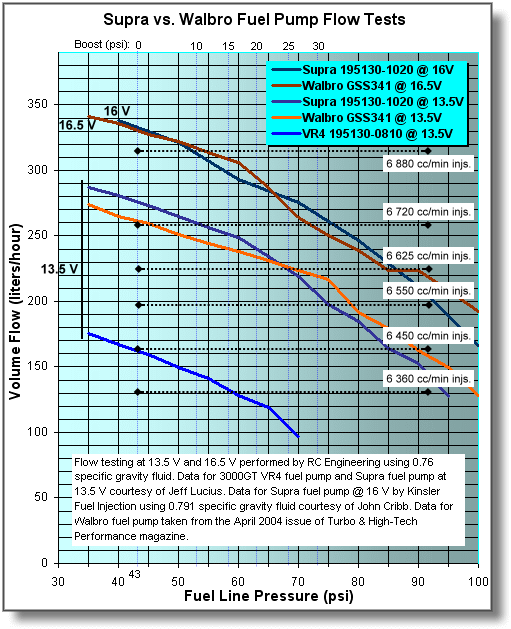
 . Amazingly, they state this pump is an upgrade for the Supra Turbo MKIV Denso pump. In fact, it flows a little less than the Supra Turbo pump at pressures up to 67 psi at 13.5 volts. It was tested to flow 262 lph at 43 psi and 13.5 volts.
. Amazingly, they state this pump is an upgrade for the Supra Turbo MKIV Denso pump. In fact, it flows a little less than the Supra Turbo pump at pressures up to 67 psi at 13.5 volts. It was tested to flow 262 lph at 43 psi and 13.5 volts.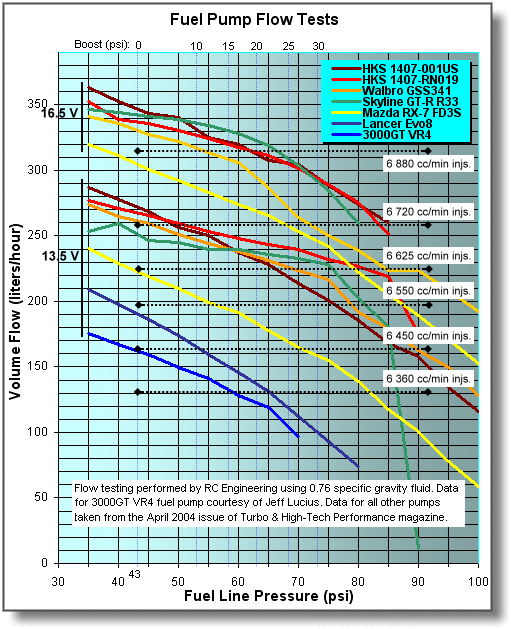
| Back | Home | Forward |